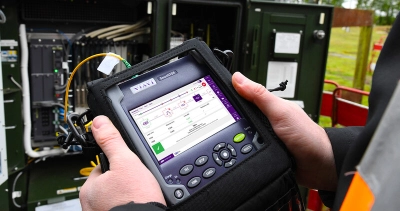Fibre testing equipment provides precise measurements for various applications.
The Duty of Optical Fiber Screening in Ensuring Top Quality and Efficiency in Connection Solutions
In today's rapidly evolving electronic landscape, the significance of optical fiber testing can not be overemphasized, as it serves as a cornerstone for making certain the top quality and performance of connection solutions. By employing a variety of testing techniques, consisting of OTDR and loss evaluations, organizations can proactively recognize and alleviate potential network concerns that may prevent performance. In addition, normal testing not just straightens with market requirements yet likewise paves the method for boosted data transmission. Nonetheless, as modern technology proceeds to advancement, the future of optical fiber screening postures interesting obstacles and opportunities that warrant closer examination.
Value of Optical Fiber Testing
The value of optical fibre testing can not be overemphasized in making certain the integrity and performance of communication networks. As the foundation of modern-day telecoms, optical fibers help with high-speed data transmission, making their reliability important to functional success. Examining works as a proactive procedure to determine potential problems such as signal loss, attenuation, and physical damages, which can compromise network efficiency.
Routine testing permits the verification of setup top quality and the detection of issues that can impact information stability - robotic vision. By employing strenuous screening protocols, network operators can reduce the threats connected with network failures, consisting of downtime and monetary losses. Moreover, optical fibre testing makes certain conformity with market standards and guidelines, enhancing the general high quality of service given to end-users.
Inevitably, the organized evaluation of optical fibers contributes to the long life and efficiency of communication systems. It makes it possible for stakeholders to make educated choices concerning maintenance, upgrades, and troubleshooting. In a landscape where information is significantly essential, prioritizing optical fibre testing is important to sustaining durable and effective connectivity options, thus supporting the demands of modern digital atmospheres.
Kinds of Optical Fibre Examinations
Various testing techniques are used to make sure the functionality and integrity of optical fibers within interaction networks. These tests can be extensively categorized right into 2 major kinds: setup examinations and upkeep tests.
Installation tests are performed immediately after the setup of optical fibre cables to confirm their performance and honesty - optical fibre diameter analyser. The most typical installation tests consist of Optical Time-Domain Reflectometry (OTDR) tests, which examine the top quality of the fibre by identifying mistakes or breaks, and end-to-end loss tests, which determine the complete optical loss from one end of the fibre to the other
Upkeep examinations, on the various other hand, are done regularly to ensure continuous performance and find potential concerns gradually. These consist of visual assessment, which look for physical damages or incorrect installments, and connection tests, which verify that the signal can go through the fibre without disruption.
In addition, progressed examinations such as Polarization Setting Dispersion (PMD) and Chromatic Diffusion (CD) tests can be carried out to evaluate the fibre's efficiency under different conditions. By employing these diverse testing approaches, service technicians can keep high requirements of high quality and integrity in optical fibre networks.
Benefits of Routine Testing
Routine screening of optical fibers plays an essential duty in preserving look at this web-site the general performance and integrity of communication networks. By conducting regular assessments, companies can guarantee that their fibre optic installations meet market requirements and operate efficiently. This proactive approach aids to recognize possible weak points and deterioration gradually, enabling prompt treatments prior to issues rise.

Cost-effectiveness is another benefit. By dealing with small problems early, companies can prevent the high costs related to major fixings or system failings. Routine testing likewise fosters conformity with governing requirements, making sure that the network abides by required security and efficiency criteria.
Common Problems Recognized
Identifying common issues in optical fiber networks is vital for keeping optimal efficiency and dependability. Various factors can add to disruptions, including physical damage, inadequate installment methods, and environmental impacts.
Physical damages, such as bends, breaks, or abrasions, can substantially deteriorate signal quality. Inappropriate setup methods, including extreme stress or insufficient safeguarding of cords, may cause increased depletion and loss of connectivity. In addition, environmental variables such as temperature variations, moisture access, and rodent disturbance can jeopardize the stability of the fiber.
Port concerns additionally regularly occur, with improper alignment or contamination bring about increased insertion loss. Splicing mistakes can introduce substantial signal degradation if not implemented with precision.

Addressing these common concerns via normal optical fiber testing not only boosts network dependability yet likewise enhances general efficiency, guaranteeing that connectivity services stay durable and reliable.
Future Fads in Testing
As the need for high-speed connectivity continues to climb, the future of optical fibre testing will significantly concentrate on automation and advanced analytics. The integration of artificial knowledge (AI) and machine knowing (ML) in screening processes will certainly allow a lot more reliable information evaluation and predictive upkeep, decreasing downtime and boosting total network reliability. Automated screening solutions will improve the assessment and accreditation of fiber networks, reducing human mistake and boosting testing throughput.
Another significant pattern is the fostering of remote testing technologies. As the deployment of fiber networks increases right into remote and underserved locations, remote testing capacities will Get More Information certainly enable professionals to keep an eye on and identify network problems without physical visibility, therefore minimizing functional prices and improving action times.
In addition, there will certainly be a shift in the direction of even more detailed screening requirements that include not only conventional loss measurements however also performance metrics such as latency and bandwidth utilization. This all natural approach will certainly promote better network management and optimization strategies.
As these patterns develop, the optical fiber screening landscape will not only boost the top quality and effectiveness of connection solutions but likewise sustain the growing intricacies of contemporary interaction networks.
Conclusion
In conclusion, optical fiber screening serves as a basic element in keeping the integrity home and efficiency of interaction networks. The ongoing dedication to regular testing not just improves data transmission but likewise aligns with industry requirements, fostering dependability in network frameworks.